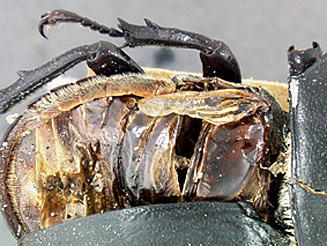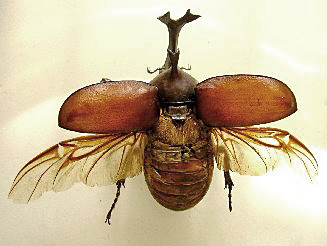|
Flightlessness in beetles
Flightlessness
in beetles and more specifically the superfamily Scaraboidea, is a subject worth
a separate mention.
 |
 |
Brachypterous Colophon westwoodi
with vestigial wing visible.
[image
M. Cochrane, Iziko
© ] |
Macropterous Scarabaeidae with wings and elytra (wing covers) fully extended.
I[image
M. Cochrane, Iziko
© ] |
Flight
is a major advantage to insects, the mobility allowing them to readily locate
food, mates, better habitats and nesting sites. Yet, in spite of what seems to
be an obvious advantage, some species have become, what is thought to be,
secondarily flightless and/or wingless. That means that although beetles were
originally flightless and later evolved the ability to fly, some of them lost
that ability subsequently. For many
and varied reasons, evolution favoured this condition in some groups.
Depending
on the degree of wing reduction, beetles are described as apterous (no wings),
brachypterous (wings reduced, usually shorter than the elytra or wing covers,
rendering the beetle flightless) and macropterous ( fully developed wings). Of
the macropterous kind there are those that fly and those that are not capable of
flight. It is interesting to contemplate these different degrees of flight
capability. Is the apterous condition the phase of having lost the ability to
fly or the phase just before wing development? Is macropterous without flight,
an evolutionary phase before flight or the phase after full ability of flight?
On the other hand, secondary flightlessness might just be scientific conjecture
and might be nothing more than what was an ancestral character all along.
Instead of evolving from soil feeding and flightlessness to having flight and
feeding on dung in a moist habitat only to lose the ability when conditions
changed, flightless species might have been flightless all along and merely
adapted to the changing conditions.
In
many species, only the female is flightless (sexual wing dimorphism). This often
relates to a balance of energy being invested in eggs and egg laying with energy
for sperm and sperm production and energy for flight to locate females.
Flightlessness
and the ability to fly seems to have evolved from a complex inter-relationship
of energy, food location and collection, mate location, reproduction and environment. Energy is required
to find and process foods, the location of mates and the successful production
and distribution of offspring. This takes place in varied and changing habitats
ranging from wet, temperate forest, savannahs to deserts. Within the varied
habitats and conditions, the food source varies from being almost soluble and easy to assimilate
such as dissolved nutrients in soils to organisms such as fungi in soils, foods
in the form of wet or dry dung, and in some cases the food that is dry and needs to be processed
before assimilation by processes like fermentation.
So, depending on each species' requirements amongst all these variations, some
evolved the need for flight and others not.
Possible factors that led to
the evolution of secondary flightlessness were: a decrease
in environmental heterogeneity, geographic/climatic variables, gender,
alternative modes of migration, change in food supply and a natural propensity
in some groups.
Flightlessness
is associated with homogenous environments such as deserts, forests, islands,
mountains, specific habitats and increased altitude. High mountains, cold and high wind would also favour flightlessness.
Flightlessness is also more common in females and parthenogenetic
species.
It
is believed that the ancestral scarabaeoids were adapted to life in the soil,
and like many flightless species today,
occurred in stable and persistent microhabitats such as soil and decomposing
wood. The progression from the passive feeding on humus in the soil to
decaying wood and then to a more active collection of and feeding on dung would
have been a natural one with the radiation of mammal species.
Where fresh dung is
the food source, rapid mobility is required to get to it before it dries out.
Collectors of dry dung, detritus and fungi in soil would require less mobility. Scholtz (2000) cites an interesting Australian beetle that feeds on detritus in
a wet, montane coastal forest region. The males collect leaves from the forest
floor and this is carried to pre-excavated burrows. There the female masticates
the leaves, compresses it into dung-like ball and lays the eggs in them and they
serve as food for the brood. All the South African Pachysoma
species occur in Desert and coastal sand habitats where they collect and process
dry dung. One wonders if these are secondary adaptions to changes in food
availability and habitat or retained ancestral behaviours adapted for a changed
environment.
South
Africa and Australia seem to be similar in that most flightless scarab species
occur in refuge areas where there has been a long history of environmental
stability such as mountains, relict forests, deserts and other arid areas.
Evidence suggests that flightless scarabaeoids not only occur in environmentally
stable habitats but also habitats that are poor in species diversity and
associated interactions and also habitats that are poor in other scarabaeoid
fauna.
Colophon home
Images and text by Margie Cochrane |
